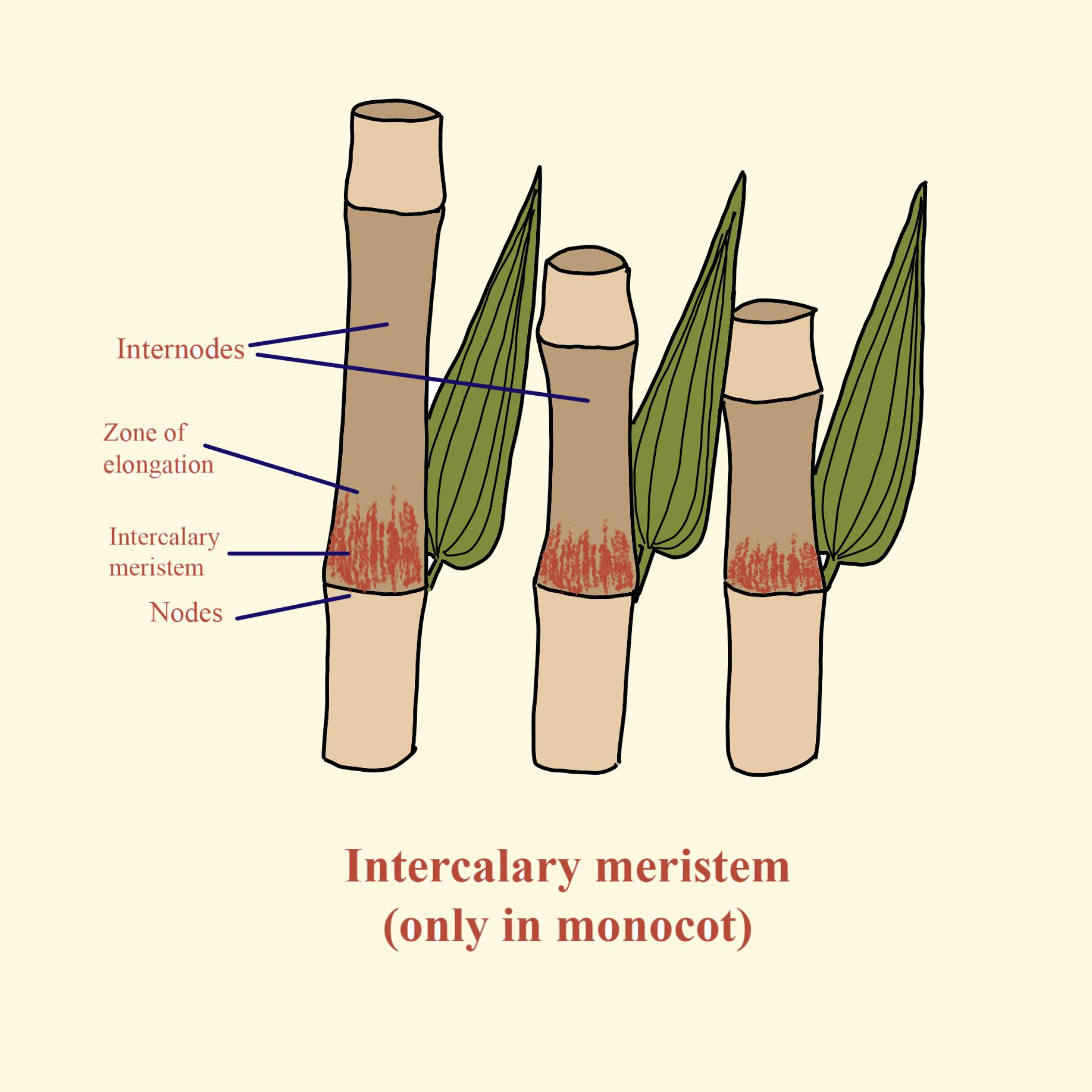
Intercalary meristem at base of Pinus leaves or nodes of grasses is responsible for
(a)Primary growth
(b)Secondary growth
(c)Phellem formation
(d)Abscission formation
Answer
483k+ views
Hint: The intercalary meristem at the base of Pinus leaves or grass nodes is responsible for a mechanism that results from the rapidly dividing cells at the shoot tip and root tip in the apical meristems. They occur mainly in tips, roots, and apiece.
Complete answer:
Primary growth is due to the intercalary meristem at the base of leaves or grass nodes. Meristems are graded as apical at the root and shoot tips, lateral at the vascular and cork cambia, and intercalary at internodes of stem regions between the places where leaves connect, and leaf bases, by their position in the plant.
Intercalary meristem cells, as apical and lateral meristems do, have the ability to divide and create new cells. They differ, however, in being found between mature areas of tissue, such as at the base of grass leaves found on mature stem tissue.
At the apices, or tips, of stems and roots, most primary growth takes place. Subsequent cell elongation leads to primary growth as well. During primary growth, the growth of shoots and roots allows plants to seek water (roots) or sunlight (shoots) on a continuous basis.
Additional Information: Secondary Growth:
-The increase in stem thickness resulting from secondary growth is due to lateral meristem activity, which is not present in herbaceous plants. The vascular cambium and, in woody plants, the cork cambium contain lateral meristems.
So, the correct answer is, ‘Primary growth’.

Note: -The increase in stem thickness resulting from secondary growth is due to lateral meristem activity, which is not present in herbaceous plants. The vascular cambium and, in woody plants, the cork cambium contain lateral meristems.
They are found in some plant stems. They can be present either at the base of the internode (for example, grass, bamboo, Equisetum, etc.) or at the base of the internode (for example, Mint). They are also present, e.g., Pinus, at the base of leaves. Through the action of this meristem, leaf length increases.
Complete answer:
Primary growth is due to the intercalary meristem at the base of leaves or grass nodes. Meristems are graded as apical at the root and shoot tips, lateral at the vascular and cork cambia, and intercalary at internodes of stem regions between the places where leaves connect, and leaf bases, by their position in the plant.
Intercalary meristem cells, as apical and lateral meristems do, have the ability to divide and create new cells. They differ, however, in being found between mature areas of tissue, such as at the base of grass leaves found on mature stem tissue.
At the apices, or tips, of stems and roots, most primary growth takes place. Subsequent cell elongation leads to primary growth as well. During primary growth, the growth of shoots and roots allows plants to seek water (roots) or sunlight (shoots) on a continuous basis.
Additional Information: Secondary Growth:
-The increase in stem thickness resulting from secondary growth is due to lateral meristem activity, which is not present in herbaceous plants. The vascular cambium and, in woody plants, the cork cambium contain lateral meristems.
So, the correct answer is, ‘Primary growth’.

Note: -The increase in stem thickness resulting from secondary growth is due to lateral meristem activity, which is not present in herbaceous plants. The vascular cambium and, in woody plants, the cork cambium contain lateral meristems.
They are found in some plant stems. They can be present either at the base of the internode (for example, grass, bamboo, Equisetum, etc.) or at the base of the internode (for example, Mint). They are also present, e.g., Pinus, at the base of leaves. Through the action of this meristem, leaf length increases.
Recently Updated Pages
Master Class 9 General Knowledge: Engaging Questions & Answers for Success

Master Class 9 English: Engaging Questions & Answers for Success

Master Class 9 Science: Engaging Questions & Answers for Success

Master Class 9 Social Science: Engaging Questions & Answers for Success

Master Class 9 Maths: Engaging Questions & Answers for Success

Class 9 Question and Answer - Your Ultimate Solutions Guide

Trending doubts
State and prove Bernoullis theorem class 11 physics CBSE

Who built the Grand Trunk Road AChandragupta Maurya class 11 social science CBSE

1 ton equals to A 100 kg B 1000 kg C 10 kg D 10000 class 11 physics CBSE

State the laws of reflection of light

One Metric ton is equal to kg A 10000 B 1000 C 100 class 11 physics CBSE

Difference Between Prokaryotic Cells and Eukaryotic Cells




